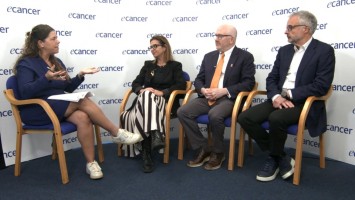Atezolizumab versus placebo in combination with bevacizumab and non-platinum-based chemotherapy in recurrent ovarian cancer
Prof Frederik Marmé - Heidelberg University, Heidelberg, Germany
We presented our data on a randomised phase III study named AGO 2.29/ENGOT-ov34 today. Maybe to start with the background first, it’s a study on immune checkpoint inhibitors in ovarian cancer. Unlike in other tumour types, immune checkpoint inhibitors as single agent have very, very limited activity in ovarian cancer and this is why people have started to look in combinations. There is a biologic rationale to combine immune checkpoint inhibitors with chemotherapy via the induction of immunogenic cell death and also with bevacizumab, for example, via the increase of T-cell infiltrate and also the inhibition of immunosuppressive effects of VEGF.
So this is the starting point of our study which was performed in patients with platinum resistant ovarian cancer. So AGO 2.29/ENGOT-ov34 included patients with a first or second relapse in ovarian cancer after a platinum-free interval of less than 6 months or a third relapse regardless of the platinum-free interval. Patients had to have a recent as well as archival biopsy for the inclusion, to have an ECOG performance status of 1 or 0 and a prior therapy with bevacizumab was allowed.
These patients were then randomised 1:1 to receive either atezolizumab as a PD-L1 inhibitor or placebo combined with either paclitaxel as chemotherapy or PLD, so pegylated liposomal doxorubicin, which are standard of care treatment options for these patients, plus in addition bevacizumab. We finally randomised 470-something patients into the study and the patient characteristics were well balanced between treatment arms. There’s a couple of points which might be important to point out – one is that above a third of the patients had received three prior lines of therapy, so rather heavily pretreated, 41% had a prior PARP inhibitor and 73% had even a prior therapy with bevacizumab, so they were bevacizumab pretreated which was allowed in the study.
At a maturity of 88% of the events we saw that the addition of atezolizumab to chemotherapy and bevacizumab did not improve the progression free survival. So the median progression free survival with atezolizumab was 6.4 months and the progression free survival in the control arm was 6.7 months and that did not reach statistical significance. Also, likewise, in the overall survival data analysis the addition of atezolizumab did not significantly improve overall survival. Median overall survival in the atezolizumab arm was 14.2 months and 13.0 months in the placebo arm. The p-value for that was 0.06 which did not reach the threshold for significance. Although at a landmark analysis at 24 months, which is shorter than our median follow-up of 27 months, there is an 8% difference in favour of atezolizumab and the curves remain separate until the end of the follow-up.
In terms of toxicities we saw the toxicities that we expected. We had more serious adverse events in the atezolizumab arm; we had more AEs attributed to atezolizumab in the atezolizumab arm; we had more immune-related adverse events but overall the toxicity profile was in line with that which was expected for the investigated agents.
We also looked at the response rates and they were similar in both treatment arms, so 40% for atezolizumab, 44% for placebo, but the duration of response was longer in the atezolizumab arm, so 8.6 months versus 6.1 months.
We also performed a subgroup analysis based on the PD-L1 status which was prospectively tested for these patients and we saw that, looking at PD-L1 positive and PD-L1 negative patients, that the PD-L1 status did not impact efficacy of atezolizumab. There were two subgroups which seemed to derive more benefit from the addition of atezolizumab, the first being the patients that had a prior treatment with bevacizumab and the second being the patients that were treated with paclitaxel within the study. We performed tests for interaction, they were negative, so these analyses remain hypothesis generating and we have also contradictory data from the ATLANTIS study concerning the effect based on the prior bevacizumab treatment. We don’t have a good explanation for the increased benefit in the paclitaxel-treated patients but there are still some studies ongoing looking specifically at paclitaxel in combination with immune checkpoint inhibitors. So maybe there is a chance for validating this effect.
So what we’ve learned now with a series of phase III studies of immune checkpoint inhibitors in combination with chemotherapy, partly also in combination with bevacizumab and others added, a PARP inhibitor as well, what we learned from that is that the immune checkpoint inhibitor, as such, even if you take different combinations, is not able to achieve a clinically meaningful benefit for the patients to bring it into routine clinical practice. But we see consistently in all of these studies that a minor fraction of patients really derive benefit in terms of OS. The problem is that we are unable to identify those by biomarkers. The way to move forward is not just to identify biomarkers, because that subgroup then would still be very small, but also to find other ways of rational combinations with other IO agents like vaccines or cytokines, genetically modified cytokines, or even a dual checkpoint inhibitor blockade to move forward. Because I think there still is a hope for immunotherapy in ovarian cancer, it’s just not going the way we are trying to achieve this at the moment.








